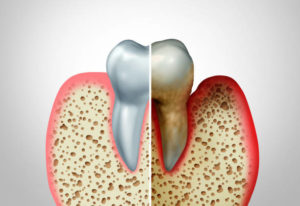 Your oral health involves much more than just your teeth. Your gums are the foundation for a healthy smile. Cavities aren’t the only threat to your dental health. According to the Centers for Disease Control and Prevention, 50% of adults over the age of 30 have gum disease. Initially, your gums may be red, swollen, or bleed easily. Over time, the infection can spread deeper into the tissues surrounding your teeth, causing periodontal pockets. Here’s what you need to know to stop the infection and get rid of the pockets.
Your oral health involves much more than just your teeth. Your gums are the foundation for a healthy smile. Cavities aren’t the only threat to your dental health. According to the Centers for Disease Control and Prevention, 50% of adults over the age of 30 have gum disease. Initially, your gums may be red, swollen, or bleed easily. Over time, the infection can spread deeper into the tissues surrounding your teeth, causing periodontal pockets. Here’s what you need to know to stop the infection and get rid of the pockets.
What is Gum Disease?
Gum disease is a preventable infection caused by poor oral hygiene habits. Plaque and tartar can accumulate near your gum line, which harbors bacteria that can infect your gums. Gingivitis is the first stage of gum disease. It’s easy to treat and won’t cause irreversible damage with treatment.
Periodontal Pockets
With no treatment, inflammation and swelling can cause pockets to form between your gums and teeth. Plaque and tartar can hide in the pockets, wreaking havoc on your dental health. Over time, gum disease can destroy the supporting structures of your teeth, including your jawbone. Eventually, your teeth can lose and fall out. Advanced periodontal disease is also linked to many health issues, including cardiovascular disease and Alzheimer’s disease.
Treating Periodontal Pockets
Your dentist checks your gum health during your semi-annual appointments. They use a special dental instrument to measure the depths of the periodontal pockets. If the infection isn’t treated quickly, the tissue that attaches the gum to your tooth can break down. Your gum line will recede and your bone won’t have the protection it needs.
Scaling and Root Planing
If your periodontal pockets measure over 3 mm, your dentist will recommend scaling and root planing, also known as a “deep cleaning.” They’ll use dental instruments to remove plaque and tartar from above and below the gum line. After the periodontal pockets have been cleaned out, your dentist will use another instrument to smooth your root surfaces. This discourages future buildup and allows your gums to reattach to your teeth.
Preventing Gum Disease
Your dentist may recommend more frequent cleanings and checkups to monitor your gum health. They will also encourage a few changes to your oral hygiene routine to keep your teeth and gums healthy.
Use a soft-bristled toothbrush and non-abrasive toothpaste to clean your teeth twice daily for 2 minutes. Commit to flossing your teeth every day to remove the buildup your toothbrush can’t reach. Finish your routine with an antimicrobial mouthwash to kill any bacteria hiding in your mouth. You’ll keep your gums healthy and enjoy minty fresh breath.
About Dr. Adam Danzig
Dr. Danzig achieved his dental degree at the New York University College of Dentistry and has regularly pursued education in various specialties, including CEREC, orthodontics, and gum disease treatment. He is an active member of many professional organizations, including the American Dental Association. Request an appointment through his website or call (978) 924-8186.



